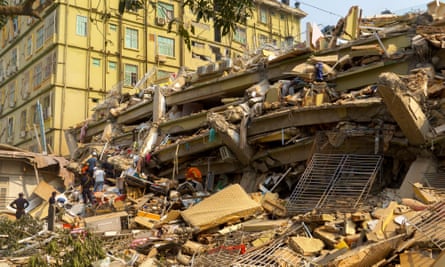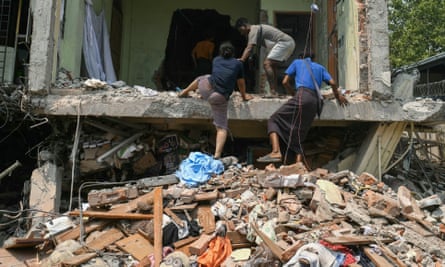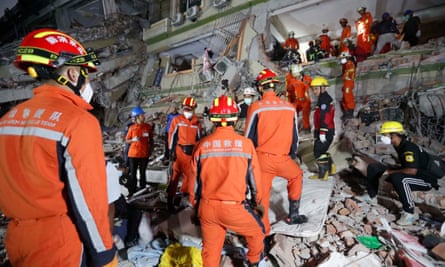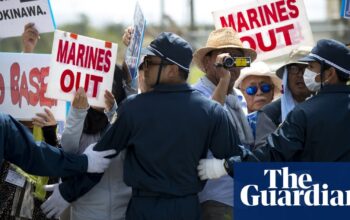Rescue volunteers, many of them poorly equipped local people, raced to find survivors in the rubble of collapsed buildings across central Myanmar, two days after a huge earthquake killed more than 1,700 people in the country and at least 18 in neighbouring Thailand.
Red Cross officials said Myanmar was facing “a level of devastation that hasn’t been seen over a century in Asia”, after a 7.7-magnitude quake struck near the centre of the country on Friday afternoon, followed minutes later by a 6.7-magnitude aftershock.
The quake has damaged and destroyed countless buildings including hospitals, damaged roads and bridges, and brought down power supplies, phone and internet connections.
“People who need help are continually calling us, but even now there are difficulties for them to reach us,” said a rescue worker in Mandalay, Myanmar’s second largest city.
Ko Doe, a rescue worker in Sagaing, said his team believed as many as 100 bodies were still to be removed from collapsed buildings in the town. “A bad smell is coming from the bodies that remain trapped, and which we are unable to save immediately. We need backhoes, cranes, and heavy-duty diggers to demolish the damaged buildings and retrieve the bodies,” he said.
In Thailand, rescue efforts continued at the site of a collapsed 30-storey tower in the Chatuchak district of Bangkok, which fell to the floor while under construction, trapping dozens of workers. Officials from Bangkok metropolitan administration said signs of life had been detected in one area of the site early on Sunday morning. Eleven people have been confirmed dead and workers are frantically searching for 78 who remain missing.
Myanmar’s ruling junta said in a statement on Saturday that at least 1,700 people were killed and more than 3,400 injured in the country, with at least 300 more missing.

The true scale of the devastation in Myanmar, which has been gripped by conflict for the past four years, could take days or even weeks to emerge, according to aid experts.
The US Geological Service’s predictive modelling estimated Myanmar’s death toll could top 10,000 and losses could exceed the country’s annual economic output.
On Sunday morning, a small aftershock struck, sending people scurrying out of a hotel for safety, after a similar tremor felt late Saturday evening, AFP reported.
Truckloads of firefighters gathered at one of Mandalay’s main fire stations to be dispatched to sites around the city.

China and Russia, two allies of the junta, have sent aid and personnel, while India, Thailand, Malaysia and Singapore have also sent assistance.
The US pledged $2m (£1.5m) in aid “through Myanmar-based humanitarian assistance organisations” and said in a statement that an emergency response team from USAid, which is undergoing massive cuts under the Trump administration, was deploying to Myanmar.
It follows a rare request by Myanmar’s isolated junta for international help. The junta chief, Min Aung Hlaing, said on Sunday he called on “all military and civilian hospitals, as well as healthcare workers” to “work together in a coordinated and efficient manner”, according to state-run media.
The earthquakes have compounded the crisis in Myanmar, which was plunged into war when the military seized power in a coup in 2021.
It is facing an armed opposition formed of people’s defence forces, which emerged to oppose the coup, and more established ethnic armed groups, that have long demanded independence.
The shadow national unity government, set up to oppose the junta, said anti-coup groups had declared a two-week partial ceasefire in quake-affected regions starting on Sunday. The military continued airstrikes following the quake, including just hours afterwards.
The national unity government said it would “collaborate with the UN and NGOs to ensure security, transportation, and the establishment of temporary rescue and medical camps” in areas it controls, according to the statement, which was released on social media.
Aid agencies have warned that responding to the disaster will be complex, given the conflict and the severe level of need. Even before the earthquake 15 million people – about a third of the country’s population – were estimated to be facing acute food insecurity. The conflict has displaced 3.5 million people and pushed the economy and health services into crisis.

The junta has been repeatedly accused of weaponising aid, blocking supplies to areas where its opponents are present.
An assessment by the UN Office for the Coordination of Humanitarian Affairs said hospitals and health facilities warned of “a severe shortage of medical supplies” and said damage to infrastructure such as roads was hampering efforts to respond to the earthquake.
In some of the country’s hardest-hit areas, people told Reuters that government assistance was scarce so far, leaving people to fend for themselves. The entire town of Sagaing near the quake’s epicentre was devastated, said Han Zin, a local person.
“What we are seeing here is widespread destruction – many buildings have collapsed into the ground,” he said by phone, adding that much of the town had been without electricity since the disaster hit and drinking water was running out. “We have received no aid, and there are no rescue workers in sight.”
But some aid and rescue personnel were beginning to arrive. Indian military aircraft made sorties into Myanmar on Saturday, including ferrying supplies and search-and-rescue crews to Naypyidaw, the purpose-made capital, parts of which have been wrecked by the earthquake.
The Indian army will help set up a field hospital in Mandalay, and two navy ships carrying supplies are heading to Myanmar’s commercial capital of Yangon, said India’s foreign minister, Subrahmanyam Jaishankar.
Teams of Chinese rescue personnel have arrived, including one that crossed overland from its south-western province of Yunnan, China’s embassy in Myanmar said on social media.
A 78-member team from Singapore, accompanied by rescue dogs, was operating in Mandalay on Sunday, Myanmar state media said.
The International Federation of Red Cross and Red Crescent Societies said in a statement that “destruction has been extensive, and humanitarian needs are growing by the hour”.
It added: “With temperatures rising and the monsoon season approaching in just weeks, there is an urgent need to stabilise affected communities before secondary crises emerge.”
Agence France-Presse and Reuters contributed to this report
Source: theguardian.com


